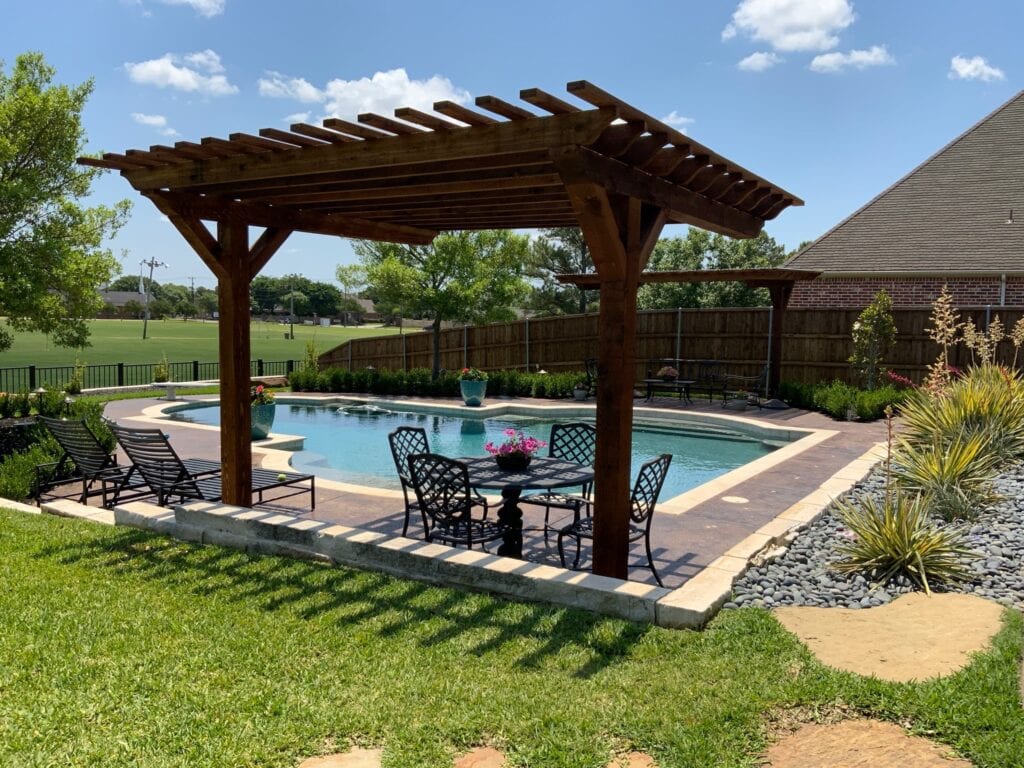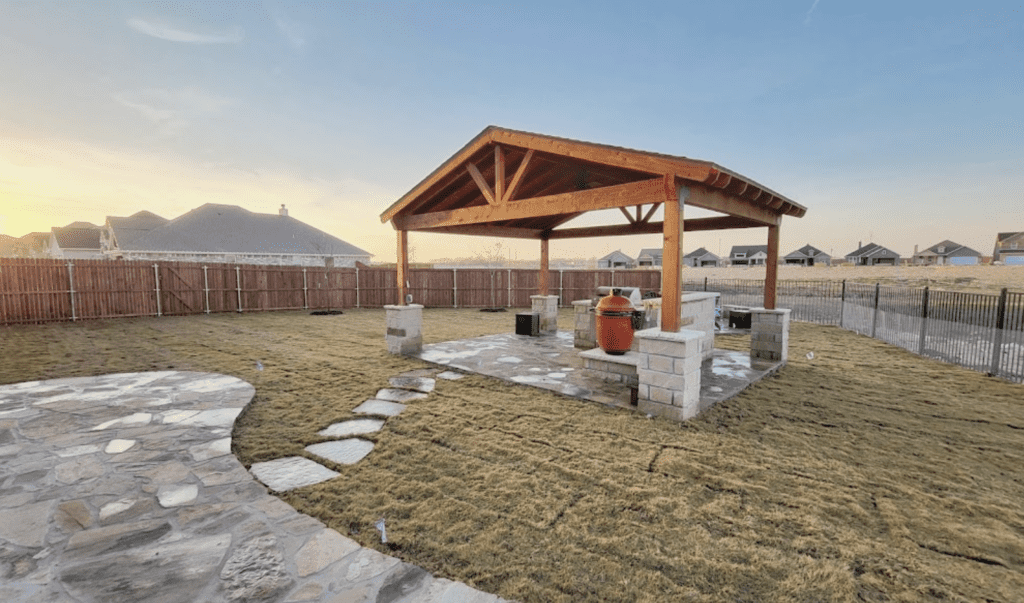There are many different elements that go into the design and overall feel of your outdoor space. Some add softness and life to your yard, and some of them add structure, hardscape vs. landscape. Both, when designed and implemented together properly, create the perfect space for you to relax, entertain, and enjoy the great outdoors with your friends and family.
Hardscape vs. Landscape: Knowing the Difference
When creating and designing your landscape, your landscaper or outdoor contractor may use the terms “hardscape” and “landscape”. But what do those terms mean? Knowing the difference between the two can help you understand and envision your landscaper’s ideas, and could even help and encourage you to create a design of your own. It will also help you know and understand how to properly care for your new space once it’s completed.
What Is Hardscape?
Simply put, hardscape is any of the non-living elements in your landscape design. As the name suggests, these are the harder design elements in your space like concrete, rocks, bricks, pavers, stone, and wood. Hardscaping also includes man-made structures like decks, pergolas, or patio covers that are used specifically in your landscaping.
What Is Landscape?
Landscape is all of the “soft,” or living, things in your design such as grass, plants, trees, and flowers. These elements, when used properly, can quickly transform your space into a calm and relaxing oasis.
As you can see, it’s pretty easy to understand the difference between the two. Getting them to work harmoniously in your design, however, could be a little tricker.
Why Does my Yard Need Hardscaping?
Hardscaping your yard is about more than just aesthetics. It serves a purpose and is extremely important to the overall function of your outdoor space. When planning and choosing your hardscaping materials, layout and design, it is important to consider how they will impact the efficiency, flow, and look of your landscaping. Retaining walls and stone stairs or paths can assist in leveling off sloping or uneven land. They can also help improve drainage and minimize runoff in areas that may get flooded with water faster. By absorbing heat from the sun, materials like stone, rock, and concrete can help dry the soil around it. This can prevent standing water, over-watering, algae and mildew, and unwanted pests. Fences and gates provide privacy and protection for your home. They define your property line and section off areas of your yard that you may want to use for other purposes.
When designed and implemented correctly hardscaping also provides fluidity from the inside of your home to the outside. Building an outdoor kitchen, deck or patio creates and provides outdoor amenities that rival those of your indoor space. An outdoor fireplace or fire pit drastically extends the use of your outdoor space well into the colder months. Having a usable living space outdoors helps encourage you and your family to spend more time outside and gives you a great place to entertain and host guests.
Tips for Using Hardscape in Your Design
- A lot of homeowners enjoy matching their hardscaping to the exterior of their house. This allows the two environments to appear to flow together seamlessly. If, for example, there is stone on the exterior of your home, try incorporating stone into your hardscaping.
- Your hardscaping should always feel like it has a purpose. In the designing process, create a focal point to draw the viewer’s gaze. Keep in mind, however, that there should also be places for the eyes to rest along the way. This is a great opportunity to also utilize the softer features of landscaping.
- Having too many straight lines can make your landscaping feel unnatural and out of place. It should feel authentic, like it was unplanned, while still retaining visual appeal. Include curves and rounded edges in your design to help break things up and bring some creativity into your outdoor space.
- Consider how your design will affect the drainage in your yard. You don’t want your landscape to be flooded or deprived of water because of your hardscaping design. Utilizing features such as retaining walls and stone steps can drastically improve the drainage in your yard. Consider areas where you consistently experience standing water or maybe even don’t get enough water, and use your materials to help fix the problem.
- If not constructed properly, the natural expansion and contraction of the earth could completely destroy your hardscaping. Plan ahead for shifting and movement. Be sure to settle hardscaping below the frost line to avoid extensive damage to your materials.
- Don’t forget to use greenery and shrubs where you can. Excessive hardscaping and a lack of landscaping can cause your space to feel cold and unwelcoming. Mixing your landscaping with hardscaping helps make it feel like it belongs there and is a part of the outdoor environment.
Adding Value (and Curb Appeal) to Your Home
Both hardscaping and landscaping can drastically add curb appeal and increase the value of your home. After all, most people won’t feel compelled to buy a house that doesn’t look nice from the outside. Some of the best hardscaping features to implement into your outdoor design and increase your home’s ROI are patios and decks, outdoor kitchens, and stonework. When it comes to landscaping, planting beautiful flowers, trees, and decorative shrubs are all great ways to improve the value of your home. When your landscaping compliments your hardscaping, your home becomes more appealing and attractive. Buyers are much more likely to have an interest in seeing more and potentially making an offer.
Learn More: Hardscaping Projects that Add Value to Your Home
Hardscape Maintenance
Hardscape requires much less care and maintenance than landscaping. But exposure to weather and changing seasons can take a toll on these surfaces. For this reason, taking preventative measures and doing some regular maintenance is extremely beneficial to the life of your hardscaping materials. Adding a protective seal to your hardscape surfaces such as wood fences, patios, and decks helps prevent cracks, chips, and other related damage. A fresh coat of stain or sealant helps to renew and freshen up the look of your outdoor materials. Filling in cracks between pavers can help block weeds and gap-widening moisture that could cause further damage.
Cleaning
Taking the time to clean up unwanted spills and messes will help prevent stains, further extending the beautiful look of your outdoor features. Unwanted growth like mold and mildew can not only stain your hardscaping but can be slippery and unsightly. Removing them will keep your family safe and protect the life of your hardscaping materials. When cleaning your hardscaping, consider the tools and cleaning agents you are using. Wire brushes and heavy-duty scrapers could create scratches and dents on many of your surfaces. And, while using a pressure washer is an effective way to clean surfaces like flagstone or concrete, it could cause damage to things like composite decking or even wood. Be mindful of how you clean and treat your hardscaping surfaces.
Learn More: Benefits of Maintaining Hardscapes
Conclusion
Using landscaping and hardscaping together in your outdoor space can create a visually appealing experience around your home. Knowing the differences between them, how to properly and efficiently use them, and how to get them to work together will make it easier to create that perfect space you’ve been dreaming of. Contact Circle D Construction for expert hardscaping services to enhance your outdoor living.



